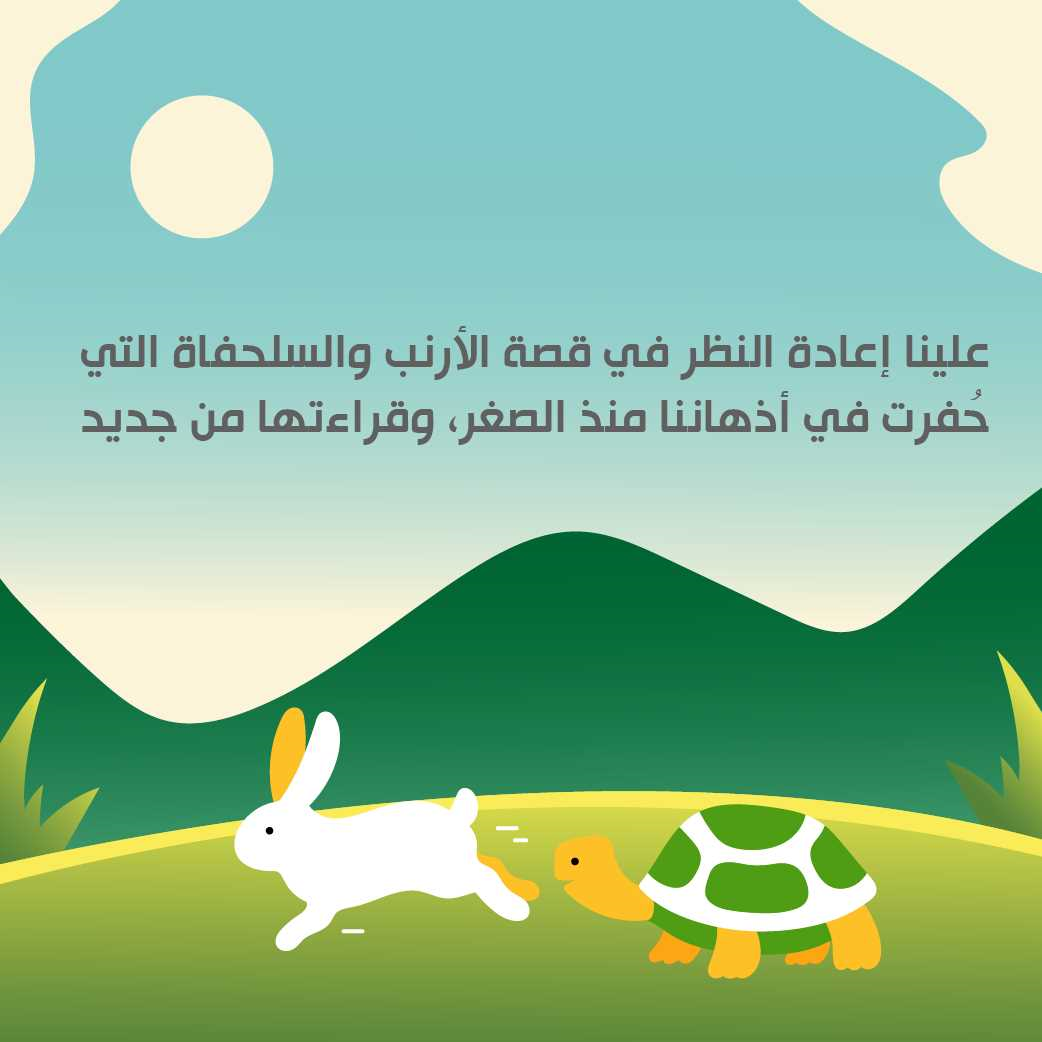Rabbit racing a turtle!

Abeer Saad Al-Saadi
Talent
12
We must reconsider the story of the rabbit and the tortoise that has been engraved in our minds since childhood, and read it again.
A rabbit and a tortoise start a race. The rabbit looks smiling and confident, while the tortoise is sweating profusely and looks distrustful. The long, winding race begins. The rabbit runs fast and gracefully, jumping in the air every now and then, covering a long distance. Then he stops and looks at the tortoise who has not covered much. He decides to take a short break in the shade of a tree, while the tortoise continues on his way with perseverance. The rabbit's nap becomes longer, and the tortoise finally wins the race.
What if we reread the story and analyze it differently? We need to know what made the rabbit slack off? What made him stop and rest until he missed the chance to win?
Here is a different scenario of the story, a fast rabbit is racing with other rabbits, do you think he will slack off and rely on his speed, as he did in his race with the tortoise, or will he summon all his abilities and skills and do his best? Even if the rabbit is persistent in his race with the tortoise, and continues to follow the race, he will most likely win, but his victory will be meaningless, as this is a race devoid of challenge and excitement, and he will not participate in it again. In any case, it is neither logical nor fair to conduct a race between a rabbit and a tortoise, as the comparison itself is unfair, as we are comparing their abilities that have a genetic origin and are unique to each of them.
Here we should not think that some of our students are slow, just make each type a race track that suits its speed. In our schools, teachers hold educational races, the track of this race contains many flags and signals (periodic and semester test scores), one of the goals of which is to speed up some of our students and move them to higher classes, with less study time, and the finish line will be at the end of the school year, and this is consistent with what the word curriculum means in Latin, which is a race track.
The educational question here is: What if this student knew implicitly and from the beginning that he would win this race? Then the race would not be at the level that satisfies him and fulfills his ambition and challenge (here boredom and apathy appear in the classrooms), so we must plan for the next year at the end of the school year. (Baska. 2019)
In this article, we will focus on several points, to ensure that we are in a neutral and safe zone between supporters and opponents of acceleration.
The most important points to consider:
1- The academic and mental aspect (the presence of a test that measures the cognitive content and required skills, so that we can ensure as much as possible that there is no knowledge gap). (Al-Juhaiman, 2018)
2- School situation (providing guidance to ensure the accelerated student’s social adaptation to the students in the accelerated class, providing support from teachers in academic subjects, and involving him in social activities). (Jarwan and Doudin, 2012; Al-Jaghman, 2018)
3- It is also recommended to conduct a test that measures the gifted student’s adaptive problems, or his adaptive behavior (his relationship with his teachers and peers).
Finally, as a gifted teacher, it must be clear to me what the situation looks like for the gifted student under study. He or she may have advanced cognitive and mental development, and advanced emotional and affective development as well. It is known that these two aspects may grow equally or one may precede the other, which causes us as teachers and parents some confusion. In addition, the high sensitivity of gifted people to the variables surrounding them increases the challenges that must be prepared for by taking early precautions before making the acceleration decision, and determining the type of acceleration appropriate for these gifted people (Al-Jaghman, 2018).
Did you benefit from the information provided on this page?
visitors liked this page
